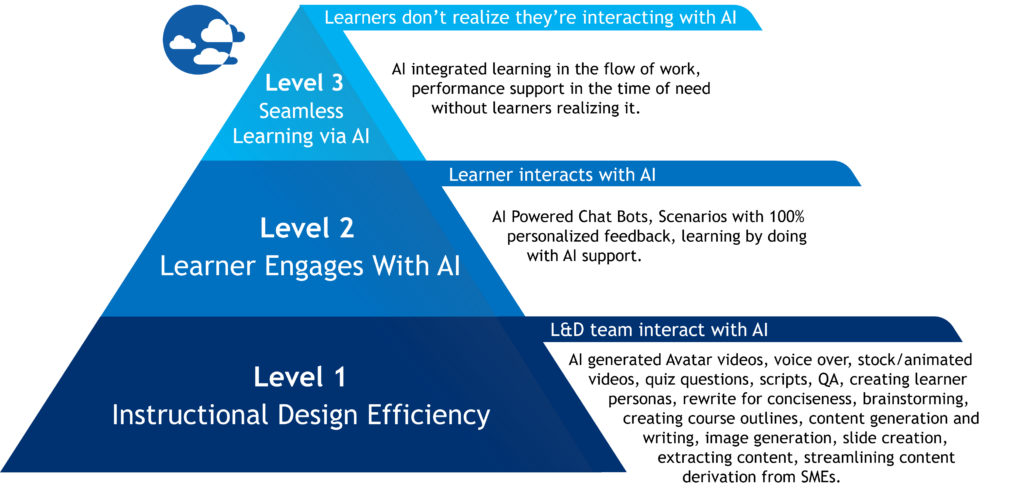Artificial Intelligence (AI) is rapidly transforming the world of Learning and Development (L&D), introducing three main levels of integration. Each level demonstrates a unique method of embedding AI in the learning process.
The first level harnesses AI to enhance the efficiency of creating learning materials, automating tasks to speed up the design process for L&D teams. This stage involves tasks like video and audio creation and editing, slide production, and course writing. Importantly, the L&D team interacts with AI, not the learners. The focus of this article, the second level, advances the application by enabling direct learner interaction with AI. This shifts the focus from traditional training to real-life skill development that directly affects job performance and aligns with company goals. The third level envisions a seamless integration of AI into learning, offering assistance exactly when and where needed, often without learners recognizing AI’s role. These levels collectively signal a shift in L&D towards more personalized, engaging, and effective learning approaches.

Direct Learning with AI: Elevating Training Efficiency and Effectiveness
The introduction of the second level of AI integration in L&D changes the game, transforming training from a task of mere delivery to an effective means of learning new skills that drive performance. AI becomes an active participant, directly engaging with learners rather than operating behind the scenes. This shift moves beyond traditional course delivery, focusing instead on practicing skills essential for job performance.
Examples of this stage are tools like AI-powered chatbots, realistic simulations, and digital approaches that support a “learning by doing” approach. This direct interaction facilitates more effective practice and meets performance objectives more efficiently.

A prime example is Chat GPT-powered Storyline interactions, which provide learner-specific feedback, creating an adaptive learning environment. Scenarios offering 100% customized role-play feedback at scale demonstrate this. Try it yourself on your non-enterprise computer with the password BTS123 and hear your personalized feedback. (As it relies on ChatGPT, if your enterprise bans that AI, this should also not work). This approach to learning, where learners interact directly with Chat GPT, makes the experience much more interactive and meaningful.
Other innovations like problem-solving platforms that simulate real-world work challenges also play a crucial role. These allow learners to apply and refine critical thinking skills within a supportive framework. AI underpins these platforms, guiding learners towards more refined problem-solving abilities. Such hands-on learning ensures that the focus extends beyond theory to the acquisition of practical, immediately applicable problem-solving skills.
Simulations, too, are pivotal, providing a safe space for skill practice where learners can experiment and learn from mistakes. These simulations adapt to learners’ actions, offering personalized feedback and challenges, crucial for mastering complex skills in a risk-free environment.
The Importance of Transitioning Beyond Traditional Courses
Moving to the second level of AI use in L&D represents more than just technological advancement; it signifies a shift in our learning paradigm. Instead of merely transmitting information through courses, this approach emphasizes active skill development and application. It moves beyond engagement and aims to make training more relevant to the workplace by ensuring direct applicability of learned skills to job functions.
This emphasis on skill practice over course completion underscores a fundamental insight: the true value of learning lies in the practical application of new knowledge. By facilitating direct interaction with AI and offering personalized feedback, this level of AI use in L&D equips learners with the skills necessary for success in their roles and adaptability to workplace changes.
In conclusion, navigating through the levels of AI integration in L&D leads us towards a future where learning is not only more personalized and engaging but also more closely aligned with the actual needs of learners and their employers. The second level, focusing on direct AI interaction for skill practice, represents a key advancement towards this future. It opens up new possibilities for creating learning experiences that are informative, transformative, and seamlessly integrated into our daily professional lives.


Recent Comments